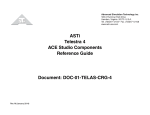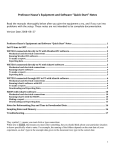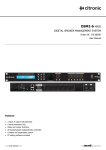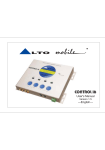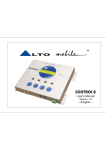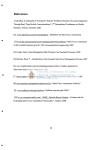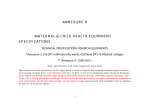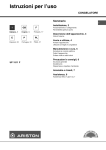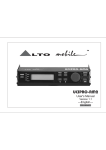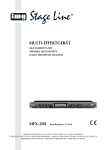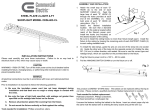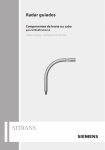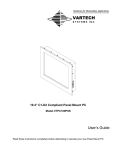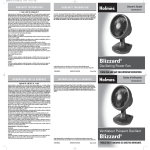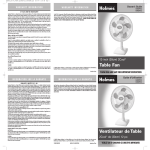Download User manual
Transcript
ELEKTROAKUSTYKA INSTRUCTION OF AUTOMATICALLY AMPLIFIERS TYPE: AMWL-DSP4 AMWLC-DSP4 AMWL-9DSP4/400 AMWL-9DSP4/600 AMWL-9DSP4/400+100 AMWLC-9DSP4/400 AMWLC-9DSP4/600 AMWLC-9DSP4/400+100 E L E K T R O A K U S T Y K A J a n R d u c h 4 4 - 3 4 0 G o d ó w , ul . 1M a j a 1 9 6 t e l . 03 2 / 47 - 5 1 - 8 0 3 d o 5 www.rduch.com.pl www.naglosnienia.com.pl www.naglosnienia.eu e-mail: [email protected] 1. Clues for users - Before putting the amplifier to the 230V currency, please read the following instruction. - Doing any unknown service to the device by any unauthorized persons makes the depriving of guarantee and can be the cause of the worsening of technical parameters and the safety of using. - ATTENTION! The device must be supplied from the plug-in socket with the safety circuit connected ( socket with grounding wheel). - In case of changing the plug-in fuse, the plug must be pulled off. - The producer can introduce some changing to the device in case of modernizations or technical progress, without the necessity to put them into the instruction as far as the basic parameters, that are included in this instruction, are not changed. The accessories of the amplifier: - service manual with the guarantee card, - spare fuse, - plug-in cable, - application software CD, 2. Using and general notices. The modern amplifiers AMC- DSP4 (Powermixer) are designed to be used in sacral buildings, large, closed areas, conference rooms, where the high quality and the hearing of speaking is required. They are cooperating with the 50V, 70V and 100V loud speakers line and with the loud speakers set of altogether impedance > = 4 Ù. The amplifier has got: 8 symmetrical microphone line channels to put in the dynamic, capacitive and wireless microphones or the device with line level output and music channel to put in the record player, tuner or CD player (LINE asymmetrical). To record, there is a separate RCA (RECORD) socket. AMWL-DSP is a modern amplifier equipped in signaling DSP processor that enables precise correction of sound characteristics in buildings with very difficult acoustic conditions. The amplifier activates only those microphones, that are used in that moment, what eliminates sound surrounding influence coming from not used microphone channels. Each 1-8 channel is equipped in symmetrical XLR input, sensitivity regulation, Phantom power.plugged in, microphone/line switch, 100Hz high pass filter, preamplification regulation, and timbre regulation (bas/soprano) designed in front of the case. In 1-8 channels, diodes signal the channel activity and the microphone transposition. 3. Arrangement of elements and sockets. 13 HIGH LOW HIGH 14 LOW HIGH LOW 15 16 HIGH DIGITAL SIGNAL PROCESSOR 7 8 9 MASTER 10 10 10 10 10 8 8 8 8 8 6 6 6 6 4 4 4 2 2 2 0 0 0 4 RECORD EAK MIC. PEAK MIC. PEAK PRESET 2 SETTINGS ENTER SPK-ZONE-LEVEL 6 POWER ON 4 2 2 0 0 PRESET 1 LINE CD - + OFF EXIT ELEKTROAKUSTYKA 1 2 3 4 5 6 7 8 9 10 11 12 The view of the front board of the AMWL-DSP amplifier. 3 26 27 28 29 30 31 32 XLR pin 1: GND MIC. 4 GAIN LEVEL 100W 100V COM SPK-ZONE OUT MIC. 3 GAIN LEVEL 1 2 3 PIN 3: - PIN 2: + MIC. 2 Phantom Mic.(on)/Line(off) HPF 100Hz Bal. INFO OUT PRESET 2 Phantom Mic.(on)/Line(off) HPF 100Hz DSP OUT 2 INPUT PANEL PRESET GND LIFT GAIN LEVEL 1 2 3 ON MIC. 1 GAIN LEVEL 1 2 3 ON Phantom Mic.(on)/Line(off) HPF 100Hz 34 Phantom Mic.(on)/Line(off) HPF 100Hz 33 1 2 3 ON ON GND LIFT MIC. 8 50V GAIN LEVEL 8 4 COM MIC. 7 GAIN LEVEL 1 2 3 DSP OUT 4 Bal. GND LIFT MIX OUT DSP OUT 1 OUTPUT 0 dB INPUT 0 dB PRE MASTER,EQ Bal. PRE MASTER Bal. GND LIFT 17 18 19 20 21 22 GAIN LEVEL 1 2 3 ON POST MASTER,EQ Bal. 230V~ / 50Hz MIC. 5 1 2 3 ON REPLACE FUSE WITH SAME TYPE AND RATINGS 35 GAIN LEVEL 1 2 3 ON 400W MIC. 6 ON LINE IN 9 1V - 10k Unbal. GND LIFT 23 24 The view of the back board of the AMWL-DSP amplifier 1- a diode signaling the activity of the particular microphone channels 2- a diode signaling the transposition of a certain microphone channel 3- gain potentiometer in microphone channels 4- gain potentiometer of LINE channel 5- Cinch socket for the external sound source to be plugged in 6- recording Cinch socket 7- presets switches on 8- a pulser to service the function on the display 9- EXIT key exit from the menu 10- USB socket for the computer to be plugged in 11- gain sum potentiometer 12- switch on/ switch off of the amplifier's power 13- timbre regulation ( bas, soprano ) for microphone channels 14- timbre regulation ( bas, soprano ) for LINE channel 15- liquid crystal display 16- 6 pointed zone regulation 17- a socket of the particular loud speaker outputs and of the zone output 18- grounding 19- XLR socket DSP OUT 4 ( Subwoofer option ) 20- Jack socket: MIX OUT - symetrical output channels: 9 (Line CD), 0dB and 1-8 enable with programmer nr: 2 (MAINSUM-2)- view on page 13. 21- XLR socket: DSP OUT 1 22- grounding disconnect switch 23- XLR socket output before the equalizer and the sum 24- Jack socket 0dB output before the equalizer and the sum 25- Cinch socket asymmetric linear input 26- loudspeaker output socket ( option! only in amplifiers with the additional 100 W power tip) 27- XLR socket: DSP OUT 3 28- XLR socket: DSP OUT 2 29- grounding disconnect switch 30- XLR socket in particular channels ( 1-8 ) 31- the particular outputs sensitivity regulation 32- 3 positioned switch: 1 Phantom power on/off 2 MIC / LINE switch 3 100 Hz high pass filter on / off 33- RJ 45 socket Preset steering panel input 34- output socket informing about Preset 2 switched on- this socket can also act to control (set off) an additional speaker circiut that is used only in Preset 2. 35- 230 V ~/ 50 Hz power socket 4 Phantom Mic.(on)/Line(off) HPF 100Hz Bal. Phantom Mic.(on)/Line(off) HPF 100Hz DSP OUT 3 70V Phantom Mic.(on)/Line(off) HPF 100Hz 100V RISK OF ELECTRIC SHOCK DO NOT OPEN Phantom Mic.(on)/Line(off) HPF 100Hz COM 25 4. Amplifier's menu control. After amplifier's connection to 230V currency by a given cable and power input (switch no 12), (no 15) on the display, Our company's logo appears, and after several seconds, there is a given screen. c.d. Preset name preset name FEW PEOPLE WEEK 3dB Preset 1 0dB ESA on - 6dB AMWL adjusted preset number eliminator pluged in - 12dB DSP-4 11:39 dB 27.1 C clock power terminal temperature input indicators (1-4) To service the menu, use the pulser handwheel (8) - press it, to get in the settings mode. Then, there is the next screen “noise gate” limiter on input 1 Noise gate white field - cursor present position NG-Noise Gate input equalizer IN 1 NG LIM1 EQ IN IN 2 LIM2 CR crossover limiter on input 2 Turning the handwheel(8) left or right, there are other menu's parts ( previous or next parts). To come into the chosen part press handwheel ( 8 ) (ENTER). To come back to the previous part press ( EXIT) ( 9 ). The first setting part is NG - noise gate Noise gate Noise gate Preset 1 0dB ENTER IN 1 NG LIM1 EQ IN Threshold -90 dB ± IN 2 LIM2 CR dB 0dB Turning the handwheel (8) left or right, the value edge of the noise gate can be adjusted from -24dB to -90dB. Another setting part is the limiter field where, the value edge can be adjusted from -30dB to +6dB and the time of the attack: slow, medium or fast. The same can be done for the limiter no2 - LIM2. Limiter 1 Limiter 1 Preset 1 6dB ENTER IN 1 NG LIM1 EQ IN Threshold 6 dB ± IN 2 LIM2 CR dB 5 6dB Attack time Slow Equalizer part EQ. Input EQ Input EQ 1 ENTER IN 1 NG LIM1 EQ IN IN 2 Preset 1 LIM2 PeakingEQ Point 1 CR 28Hz choice of one from ten equalizer’s points 0.05oct 0.0dB filter type choice PeakingEQ, LoSh6, LoSh12, HiSh6, HiSh12 frequency filtrer width setting gain attenuation adjustment (0,05 ÷ 3 oct.) settings (-12dB ÷ +12dB) (20Hz ÷ 21,2kHz) Crossover part. Crossover Crossover ENTER IN 1 NG LIM1 EQ IN Preset 1 Crossover Input 1 do Output 4 IN 2 LIM2 CR adjustment of output 4 to input 1 or 2 Gain part. Volume Volume VOL EQ 1 DLY FBS OUT1 VOL EQ 2 DLY FBS OUT2 VOL EQ 3 DLY FBS OUT3 VOL EQ 4 DLY FBS SB OUT4 Preset 1 2 ENTER 4 3 gain adjustment of particular inputs 1 - dB -14dB -15dB 0dB Output equalizer part: EQ1,EQ2,EQ3,EQ4. Output 1 EQ Output 1 EQ VOL EQ 1 DLY FBS OUT1 VOL EQ 2 DLY FBS OUT2 VOL EQ 3 DLY FBS OUT3 VOL EQ 4 DLY FBS SB OUT4 Preset 1 filter type choice PeakingEQ, LoSh6, LoSh12, HiSh6, HiSh12 PeakingEQ Gain adjustment (-12dB ÷ +12dB) ENTER Point 1 315Hz choice of one from five equalizer points 0.05oct -5.0dB filter with adjustment (0,05oct ÷ 3oct) frequency settings (20Hz ÷ 21,2kHz) In the same way, equalizer adjustments for 2,3,4 outputs can be programmed. Delaying part Delay VOL EQ 1 DLY FBS OUT1 VOL EQ 2 DLY FBS OUT2 VOL EQ 3 DLY FBS OUT3 VOL EQ 4 DLY FBS SB OUT4 ENTER Delay preset 1 Output 1 Output 2 Output 3 Output 4 Mode 0.0 m 6 0.0 m 0.0 m 0.0 m m delaying adjustments (0 ÷ 85m) measurements regulation (m, cm, ms) Elimanator part. FB Suppressor FB Suppressor VOL EQ 1 DLY FBS OUT1 VOL EQ 2 DLY FBS OUT2 VOL EQ 3 DLY FBS OUT3 VOL EQ 4 DLY FBS SB OUT4 ENTER Select out Method Frequency preset 1 Output 1 phase shifter - Hz output choice ( on which output the eliminator is to be off) decoupling eliminator method choice ( adaptive, phase shifter) frequency choice for phase shifter method Subwoofer part. Subwoofer Subwoofer VOL EQ 1 DLY FBS OUT1 VOL EQ 2 DLY FBS OUT2 VOL EQ 3 DLY FBS OUT3 VOL EQ 4 DLY FBS SB OUT4 ENTER LP Filter Frequency Slope preset 1 off 200Hz 6dB/oct. subwoofer turn on/off filter’s cut off frequency adjustment (120 Hz ÷ 472 Hz) filter slope steepness choice Presets part. Presets Presets O P T I O N PRESETS PASSWD RTC GENERAL ENTER SERVICE preset 1 Preset Name Copy preset Reset settings preset 1 change start start Clock and date Clock and date PRESETS PASSWD RTC GENERAL ENTER SERVICE preset 1 change Set time Set date change Date table change Preset 2 in sunday yes copy of chosing preset’s settings to the second preset time adjustment date adjustment recording dates board for preset 2 automatic change of presetu 2 for Sunday adjustments of the possibility of displaying the control indicator (vertical or horizontal) General options part. General options preset 1 General options O P T I O N renaming preset chosen preset’s name edition back to previous settings Clock and date part. O P T I O N preset choice PRESETS PASSWD RTC GENERAL ENTER SERVICE Level meter Mode EQ Language vertical line english choice of displaying graphs mode EQ (filled, line) ( language choice polish, english) Passwords part.. Passwords Passwords O P T I O N PRESETS PASSWD RTC GENERAL SERVICE ENTER Lock settings Change password Reset password servicing mode (only for servicemen) 7 preset 1 off change change password saving settings turn on/off change of password saving seiings adjusted password reset - new one is automatically set into zeros (0000) 5. Amplifier's control settings by the computer All settings introduced by the amplifier's control panel can be also done by the PC computer. To get the possibility of the amplifier control by the computer, the program MWL Easy Manager must be installed ( it is on the CD added). MWL Easy Manager program is created only for the configurations of AMWL-DSP4 series. Licensor is not responsible for any harm of the program operation or for the wrong use of the program. MWL Easy Manager installation instruction I. Program MWL Easy Manager requires the installation of Microsoft. NET Framework 3.5 Service Pack 1 for Windows NT, XP, 98 system ( for Windows Vista and windows 7 systems - there is not necessary). Installation file is on CD added. Dotnetfx35.exe platform can be downloaded from the Microsoft II. In the catalogue VCM Driver you can find drivers for use the USB port from the amplifier AMWL-DSP4 (CDM2.04.16.exe)- also need to be installed III. After dotnet35fx.exe installation MWL Easy program can be installed Installation file is in Rduch MWLEasyMgr 2.0 Install/Setup.exe IV. After the program installation, it should work automatically. V. After switching the amplifier on , program automatically detects port, where the device is installed. Switching the amplifier on, is not necessary- parameters can be set in the program and than can be recorded in the File first and aflter that the amplifier can be switched on and the data can be copied. To join the amplifier with the computer, in the menu “ Comunication”, the order “join” should be chosen. This window appears and after choosing the device, the order “Join” should be clicked on once again . 8 settings part particular parts of settings place to open “Settings panel” To record the project to the file, the option "Record the project” (Ctrl+S) in menu "file" should be chosen. “Limiter” fold. handwheel to set the edge value (dB) “options” - Presets - preset’s name part - “Equalizer input”. frequency regulation (20Hz ÷ 21,2kHz) filter width settings (0,05oct ÷ 3oct) filter type choise (PeakingEQ, LoSh6, LoSh12, HiSh6, HiSh12) gain attenuation regulation (-12dB ÷ +12dB) 9 attack time choice field place to record the edge value (dB) Crossover part - is created for ordering the output number 4 to input no 1 or no 2. to input 1 are assigned all inputs of the amplifier, and to input 2 are assigned input 9 (LINE CD) 0 dB and inputs 1-8 enabled with programmer 2 (MAINSUM-2) menu “Options” - language - language choice (Polish, English) “Gain part”. gain regulation of outputs 1 - 4. place to record the values (dB) “No 1 output equalizer” part. frequency regulation (20Hz ÷ 21,2kHz) filter width setting (0,05oct ÷ 3oct) filter type choice (PeakingEQ, LoSh6, LoSh12, HiSh6, HiSh12) gain attenuation regulation (-12dB ÷ +12dB) 10 “delay” part delay adjustment for particular outputs (0m ÷ 85m) place to record the delay values “Eliminator” part eliminator’s decoupling method choice frequency choice for phase shifter method output choice, it means, on which output the eliminator is to be turn on “Subwoofer” part the Subwoofer works after pressing the switch "ON" (Subwoofer option is available only in channel no 4) frequency settings of Subwoofer’s filter cut off ranged 120Hz ÷ 472Hz subwoofer’s filter slope steepness choice 11 6. Menu s tructure of MWL Easy Manager program MENU MWL Easy Manager FILE NEW PROJECT Ctrl+N OPEN PROJECT Ctrl+O SAVE PROJECT Ctrl+S SAVE AS... PRINT Ctrl+P CLOSE EXIT Alt+F4 COMMUNICATION CONNECT Ctrl+Shift+C DISCONNECT SAVE THE SETTINGS OPTIONS LANGUAGE POLISH ENGLISH PRESETS PRESET’S NAME DATE BOARD PRESET COPY ZERO SETTINGS WINDOW CASCADE PROJECT’S NAME HELP ABOUT THE PROGRAM 12 7. Prioritys. 1 2 3 4 5 6 7 8 ON Programmer nr 1 1 2 3 4 5 6 7 8 ON Programmer nr 2 (MAINSUM 2) 1 2 3 4 5 6 7 8 ON Programmer nr 3 (MAINSUM 1) Programmer nr 1 - default settings: all switches (1-8) in the top position (OFF). Switching any of the eight switches to the bottom position (ON) turns off the automatic in each channel. This is useful if you want to use one channel as a linear channel (music). ATTENTION! If you want to use priorities, the channel switch must be in the top position (OFF). Pict. 1 programmer channels 1-8 1 2 3 4 ON L.MIC ATTEN. M.AUTO OUT2 P. Programmer nr 4 top position OFF bottom position ON Adjusting the sensitivity of the channel LINE-CD ATTACK- switching Microphone level control switch TIME-backup time control of active microphones Programmer nr 2 - assignment of input channels 1-8 to the output channel mix 2 (MAINSUM 2). Assigned to input 2 (IN2) in the DSP and the output jack socket (MIX OUT). Programmer nr 3 - assignment of input channels 1-8 to the output channel mix 1 (MAINSUM 1). Assigned to input 1 (IN1) in DSP. Programmer nr 4 - default settings: switches 1 and 2 in position (OFF), switches 3 and 4 in position (ON). Switch 1 - OUT2 PRE/POST GATE: upper position (OFF) POST GATE - all channels for MAINSUM-2 are assigned to the automatic. Bottom position (ON) PRE GATE - signals are assigned before automatic. Switch 2 - AUTO/MANUAL: upper position (AUTO) - mixer auto work function; bottom position (MANUAL) standard mixer work. Switch 3 - ATTENUATION OFF: inactive microphone mute Settings, upper position - completely mute; bottom position - mute -15 dB. Switch 4 - LAST MIC: upper position (OFF) - recently used microphone turns off after speaking, bottom position (ON) - recently used microphone is still active after the speaking. ATTENTION! If you want to use a priority, this feature must be disabled (upper position OFF). Programmer of channels(1-8) - default settings: All switches in the top position (OFF). Used to set the superiority of microphones. lider 1 5 deputy 2 6 3 7 4 Microphones 8 Setting of any priorities configuration: switching of any switches in any channel's programmer causes the setting of priority precedence of this channel over the previous chosen channel. For example: switching in channel no 1 programmer, the switch no 4 down (ON) causes that microphone no 1 can stop work of microphone no 4. Lower configuration (picture no 3) shows the setting of the priority for the microphone no 1 and no 2 (picture no 2). The microphone no 1 has the priority over the microphones from 2 to 8, and the microphone no 2 has the priority over the microphones from 3 to 8, but is subordinate to the microphone no 1. It means, that the speeches of the microphones 3-8 can be stopped in any time by the leader (1) or his deputy (2), but the speech of the deputy (2) can be stopped only by the leader (1). Pict. 2 1 2 3 4 5 6 7 8 ON 1 2 3 4 5 6 7 8 ON 1 2 3 4 5 6 7 8 ON 1 2 3 4 5 6 7 8 ON 1 2 3 4 1 2 3 4 5 6 7 8 ON 1 2 3 4 5 6 7 8 ON 1 2 3 4 5 6 7 8 ON 1 2 3 4 5 6 7 8 ON 5 6 7 8 13 Pict. 3 Lower configuration (pict. 4) shows the situation for three microphones, where each of them has the priority to two ones left. In such a configuration, the priority goes to that microphone which is activated as the first one. So, when he speech to tsomebody starts speaking to microphone no 2, the microphones no 1 and 3 are not active till the end of the microphone no 2. Microphones no 1 and 3 behave analogically. Such a configuration is possible for all eight microphones. Thanks to that, there is a situation, where only one microphone is always active and it makes impossible for somebody else to interrupt, what is valuable for the order of the conference 1 2 3 4 5 6 7 8 ON 1 2 3 4 5 6 7 8 ON 1 2 3 4 5 6 7 8 ON 1 2 3 4 5 6 7 8 ON 1 2 3 4 5 6 7 8 ON 1 2 3 4 5 6 7 8 ON 1 2 3 4 5 6 7 8 ON 1 2 3 4 5 6 7 8 ON 1 2 3 4 5 6 7 8 Pict. 4 8. Configuration and operation of the amplifier with additional power terminal (AMWL-9DSP/400+100). AMWL-DSP4 amplifiers have an additional 100W power terminal (option), where the delay can be set. 100 W terminal can be switched on output DSP OUT 1 [21], DSP OUT 2 [28], DSP OUT 3 [27] or DSP OUT 4 [19]. It is the switch inside the amplifier. Red arrow in the picture on the right, shows where it is. The switch is described as the DSP outputs 1-4. SACRYSTY 13m AMP. The picture shows the typical use of the amplifier in that version The main power terminal operates on one loudspeaker’s circuit (red colour) but the other circuit (blue color)loudspeakers are spaced. Then, it is possible to adjust demanding delay on the DSP additional 100W power terminal, which operates on this loudspeaker’s circuit. The additional 100W circuit can also be activated via connector INFO OUT PRESET 2. This means that for Preset 1, which is activated when for example in the church are "little people" the additional 100W circuit is inactive (break on connector INFO OUT PRESET 2). However, when in the church are a "lot of people" for enabled Preset 2, the additional speaker circiut 100V is activated. An example of the AMWL-DSP4/400+100 amplifier use 13 9. AMWLC-9DSP4 amplifiers. Mic.1 Mic.2 Mic.3 Mic.5 Mic.4 Mic.6 COMPRESSOR EKSPANDER COMPRESSOR EKSPANDER COMPRESSOR EKSPANDER COMPRESSOR EKSPANDER COMPRESSOR EKSPANDER COMPRESSOR EKSPANDER COMPRESSOR EKSPANDER EKSPANDER COMPRESSOR Each microphone channel of AMWLC-9DSP4 amplifiers is additionaly equipped with Compressor-Expander. Practically, compressor-expander allows to reach the fixed volume level independently of the input signal level. Compressor - expander parameters settings are fixed with switches and potentiometers that are located in the upper cover of the amplifier. Mic.7 Mic.8 Expander adjustment Compressor adjustment in given channel in given channel Switch on/off in given channel 10. XLR microphone pin connection: 2 - hot (+ve) 2 - hot (+ve) 3 - cold (-ve) 1 - chassis ground Symmetrical input (operating with Phantom power recommended) connection3 and 1 1 - chassis grounding Asymmetric input ( plug in for the cable to 5m length at the asymmetric input Phantom power off! ) 11. Jack pin connection: INSERT Socket For the feedback eliminator, the equalizer, the expander compressor, the delaying line to be connected output 0 dB and input 0 dB connection symmetrical hot(+ve) Asymmetric signal input coming back of the signal cold (-ve) chassis grounding signal output chassing grounding chassis grounding chassis grounding terminal terminal ring ring sleeve sleeve 14 ON OFF 4Ù ZONE 100V 100V 100V 100V 100V 12. AMWL-9DSP amplifier operation in the sound system. ... 8Ù ... Delay XLR pin 1: GND PIN 2: + PIN 3: - Bal. GND LIFT MIC. 4 POWER: 400 Watt GAIN LEVEL 100W 100V Made in Europe COM SPK-ZONE OUT MIC. 3 GAIN LEVEL 1 2 3 MIC. 2 GAIN LEVEL 1 2 3 ON MIC. 1 GAIN LEVEL 1 2 3 ON Phantom Mic.(on)/Line(off) HPF 100Hz DSP OUT 2 AMWL-9 DSP4/400+100 Phantom Mic.(on)/Line(off) HPF 100Hz ELEKTROAKUSTYKA MODEL: Phantom Mic.(on)/Line(off) HPF 100Hz INFO OUT PRESET 2 Phantom Mic.(on)/Line(off) HPF 100Hz INPUT PANEL PRESET 1 2 3 ON ON GND LIFT MIC. 8 50V GAIN LEVEL 8 4 COM MIC. 7 GAIN LEVEL 1 2 3 DSP OUT 4 Bal. GND LIFT MIX OUT MIC. 5 GAIN LEVEL 1 2 3 ON 1 2 3 ON DSP OUT 1 OUTPUT 0 dB INPUT 0 dB POST MASTER,EQ Bal. PRE MASTER,EQ Bal. PRE MASTER Bal. GND LIFT 230V~ / 50Hz GAIN LEVEL 1 2 3 ON 400W MIC. 6 ON LINE IN 9 GND LIFT PANEL PRESET PRES.2 ON PRES.1 OFF Power 230V Amplifier or ACML column Amplifier eg. external circiut Amplifier or ACML column (delay) Amplifier or ACML column (delay) Amplifier or ACML column (delay) 15 Mixer Phantom Mic.(on)/Line(off) HPF 100Hz Bal. Phantom Mic.(on)/Line(off) HPF 100Hz 70V DSP OUT 3 Phantom Mic.(on)/Line(off) HPF 100Hz 100V Phantom Mic.(on)/Line(off) HPF 100Hz COM RISK OF ELECTRIC SHOCK DO NOT OPEN CD 1V - 10k Unbal. 13. Technical data AMWL-9DSP4 AMWL-9DSP4 Output power (sinus) 400W, 600W, 400W+100W Microphone inputs, symmetrical and electronic - MIC/LINE switch - MIC sensitivity control - LINE sensitivity control - impedance - phantom power supply - HPF filter - bass, soprano control inputs XLR: 1-8 yes -40dB -15dB -15dB +5dB 1,6 kÙ 24V DC 100 Hz, 6dB/oct. ±12dB, 100 Hz, 10 kHz, shelving filter green diode - aktiv channel red diode - overdrive input RCA: 9 -10dB +12dB 10 kÙ ±12dB, 100 Hz, 10 kHz, shelving filter double, peak, on DSP input and on power end -90dB -25dB ±12 dB, 0,05 3oct. 20Hz 21,2kHz LoSh6, LoSh12 HiSh6, HiSh12 Peak ±12 dB, 0,05 3oct. 20Hz 21,2kHz LoSh6, LoSh12 HiSh6, HiSh12 Peak of adaption; phase shift 0 - 85 m only in AMWLC yes 100V ,70V, 50V, 8Ù, 4Ù 6-degree from 0-100V 40 - 22 000 Hz <0,1% from -5°C to +40°C 443 x 135 x 340 13,5 - signaling Universal input (mono) - input sensivity - impedance - bass, soprano control Limiter noise gate 10-point parametric equalizer on DSP input 5-point parametric equalizer acoustic feedback suppressor delay line expander- compressor in channels preset choice non- grounded symmetrical output adjustable zonal output frequency band non-linear distortions work temperature measurements: width/height/depth [mm] weight [kg] 16 RISK OF ELECTRIC SHOCK DO NOT OPEN AVIS: RISQE DE CHOC ELECTRIQUE ! NE PAS OUVRIR ! UWAGA RYZYKO PORA¯ENIA PR¥DEM NIE OTWIERAÆ RISK OF ELECTRIC SHOCK DO NOT OPEN UWAGA RYZYKO PORA¯ENIA PR¥DEM NIE OTWIERAÆ WARNING OF DANGEROUS ELECTRICAL VONTAGE! IN THE HOUSING ARE NOT PROTECTET ELECTRONIC COMPONENTS WHICH HAVE A HIGHT ENOUGH CHARGE. IT CAN BE DANGEROUS! THE EXCLAMATION POINT IS A FORM OF GUIDANCE IS NEEDED IN SUPPORT AND MEINTENANCE OF THE INSTRUMENT CAUTION TO PREVENT ELECTRIC SHOCK, DO NOT REMOVE TOP COVER, NO USER SERVICEABLE PARTS INSIDE. REFER SERVICING TO QUALIFIED SERVICE PERSONNEL WARNING TO REDUCE THE RISK OF FIRE OR ELECTRIC SHOCK DO NOT EXPOSE THIS EQUIPMENT TO RAIN OR MOISTURE. 17 Control card (Noise generator) control INPUT 0 dB Pre Master INPUT 0 dB Post Master Microphone – linear input Linear input Recording Power output ( 40W, 8W, 50V, 70V, 100V) 100 Hz filter Delay regulation Feedback eliminator regulation Zone regulation Compressor – expander control .................................................. Date ........................... Typ ............................. Number ........................ Output power P U Z 200W/100V/50Ù 400W/100V/25Ù 600W/100V/16,6Ù .............................. Computer control : Connection with MWL Control program test Correctness of saving the settings Factory reset Acoustic control : Microphone – linear input Linear input Phantom power Timbre regulation of microphone – linear input Equalizer timbre regulation Feedback eliminator regulation 100 Hz filter Inactive microphone mute “LAST MIC” function “AUTO/MANUAL” function Priorities for particular microphone channels Noise and hum level control General control : 230V AC power Fuse Ground measurements of the device ( according to VDE 0701 norm) Other connections and connectors control Optical control of the whole Notices: ............................... ........................................... ........................................... ........................................... ........................................... Signature ............................... 18 GUARANTEE CARD NO............................. Below mentioned, efficient and in a good condition device is given to the buyer on …………..according to the rules stated in articles no 577-582 of the Penal Code. Rduch Elektoakustyka gives the buyer a guarantee on the proper working device for 36 months. Name of this device .................................................................................................... Rduch Elekroakustyka company, located in Godów, 1 Maja Street 196, tel. (032) 4751803 to 06, fax. (032) 475 18 07, is called a producer in the further part of the contract. I. OPERATING CONDITIONS 1. Plug – in power socket 230 V /50 Hz should have grounding or neutral grounding. 2. The device should be situated in a place with the temperature between +5ºC to +40ºC and of the humidity between 8 to 80%. 3. The device should not be a subject to vibration, should not be placed near the sources of strong electromagnetic fields and should be protected against the excessive sun exposure. II. WARRANTY STATEMENTS 1. Warranty period starts from the date of selling the device by the producer. 2. In order to repair the device during the warranty period, it should be delivered to the company after the previous call or fax. 3. The producer provides 7 day repair period counted from the date of the adoption of the device to repair. 4. Requirement for a complaint is to provide the device in the original packing, with the guarantee card, to the place, where the device was bought. 5. In case of the damage of the device during the warranty period, that are caused because of the producer, or hidden defects in the material, the producer reserves the right to exchange the device into another one that is free of defects after having examined the causes of the device malfunction. III. BEYOND THE WARRANTY 1. The warranty does not cover the mechanical damage or the damage caused by the user, or the damage caused by failure to comply with the universal principles of operation of the equipment and the requirements stated in point no 1. 2. Mechanical damages or other ones, not associated with the operation of the device, result in loss of warranty. 3. Tuning, regulations or the exchange of the fuses are not the subject to the warranty. 4. Producer, as the servicing part, reserves the rights to estimate and qualify the level of the damage. 5. In case of delivering the device in a good condition or the device that was not previously reported, the servicing costs, cleaning, testing and transport costs are paid by the person or the company that complain. 6. The guarantee card is invalid without the producer’ s signature, date or the company stamp. .................................. Date ..................................................... Stamp and signature Warranty and post- warranty service Date Stamp and serviceman signature Notices 19




















